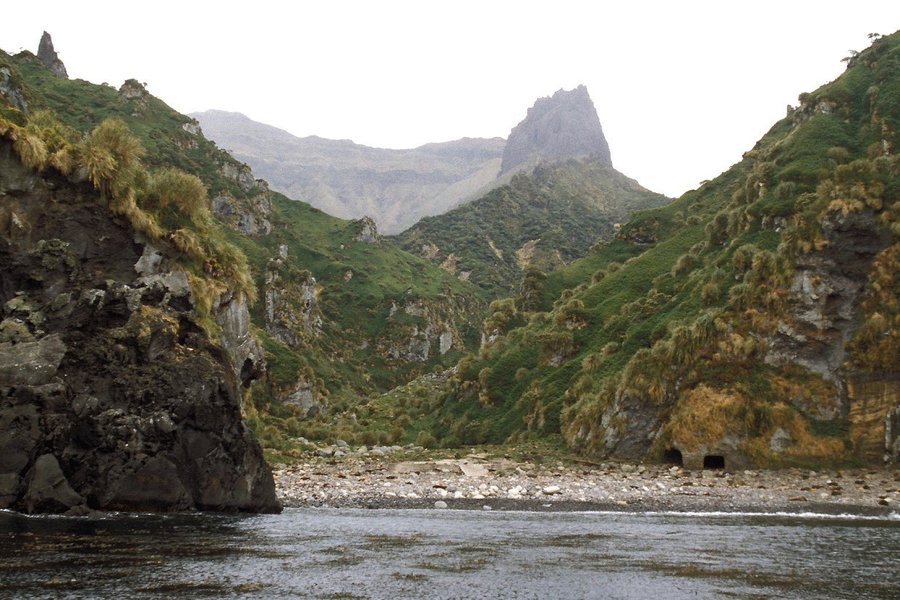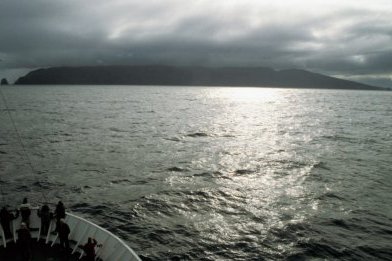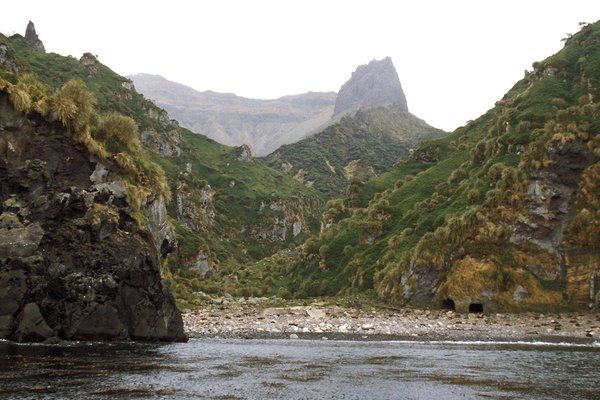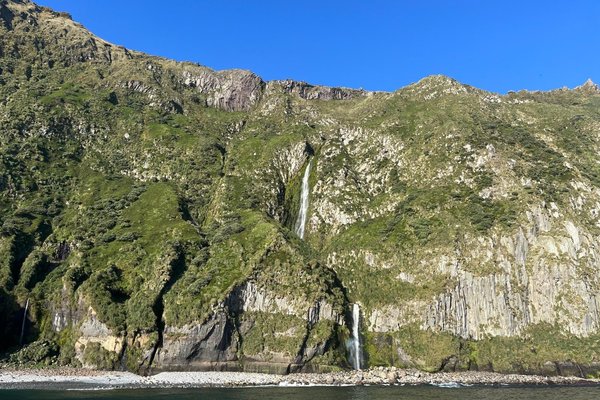United Kingdom
Gough and Inaccessible Islands
Gough and Inaccessible Islands are known for their undisturbed state and large seabird population.
These two islands in the Tristan da Cunha archipelago are volcanic islands rising from the South Atlantic Ocean, about 350km from each other. Gough Island holds almost the entire world population of the Tristan albatross and the Atlantic Petrel, and it has two endemic land birds including the almost flightless Gough moorhen. Inaccessible Island is characterized by steep cliffs around its entire coastline. It supports 10% of the global population of Northern Rockhopper Penguins and is the most important breeding site for Great Shearwaters.
Community Perspective: This is a rare site to visit. Solivagant did so in 2002 on an expedition cruise taking in the mid-Atlantic islands, and reports on the circumnavigation of Gough Island, the luxuriant vegetation and orgasmic twitchers.
Site Info
Official Information
- Full Name
- Gough and Inaccessible Islands (ID: 740)
- Country
- United Kingdom
- Status
-
Inscribed 1995
Site history
History of Gough and Inaccessible Islands
- 2004: Extended
- Extension to include the neighbouring Inaccessible Island and the surrounding marine zone extending out to 12 nautical miles
- 2004: Name change
- From "Gough Island Wildlife Reserve" to "Gough and Inaccessible Islands"
- 2003: Requested by State Party to not be examined
- Possible extension withdrawn
- 1995: Inscribed
- Inscribed
- Type
- Natural
- Criteria
- vii
- x
Links
- UNESCO
- whc.unesco.org
- Official
-
- tristandc.com — Inaccessible Island
- tristandc.com — Gough Island
All Links
UNESCO.org
- whc.unesco.org — whc.unesco.org/
Official Website
- tristandc.com — Inaccessible Island
- tristandc.com — Gough Island
News Article
- May 4, 2023 bbc.com — Gough Island: Worker sought for one of world's remotest places
- Dec. 16, 2021 bbc.com — Heartbreak over 'failed' bid to remove Gough Island's mice
- Nov. 14, 2020 theguardian.com — Waters around Gough Island are to become one of the world’s largest marine sanctuaries to protect wildlife.
- March 21, 2011 oceandoctor.org — Oil from the wrecked freighter Inaccessible Island
- May 20, 2008 guardian.co.uk — Giant carnivorous mice threaten world's greatest seabird colony at Gough Island
Community Information
- Community Category
- Natural landscape: Insular
- Natural landscape: Marine and Coastal
Travel Information
One thousand visitors or fewer
Not open to tourists
Takes more than 5 days to visit
Recent Connections
-
Oceanic Dolphins
Dusky dolphin and False killer whale (U…
-
Named after individual people
Charles Gough, who reputedly rediscover… -
Takes more than 5 days to visit
22 days cruise
Connections of Gough and Inaccessible Islands
- Individual People
-
-
Da Cunha Family
Tristan da Cunha was the first person to record having seen the archipelago which includes Inaccessible Island -
Tristão da Cunha
Tristão da Cunha discovered the Tristan da Cunha Archipelago, which was named after him. Gough Island is part of that Archipelago.
-
- Geography
-
-
Dependent territories
Part of the British overseas territory of Saint Helena, Ascension and Tristan da Cunha -
Marine sites
390000h M (after extension in 2004), 7900h T -
Uninhabited islands
Inaccessible Island is uninhabited, Gough Island has a South African weather station -
Atlantic Ocean
-
Isolated WHS
2600 kms from Robben Island -
Archipelagos
Tristan da Cunha - (Volcanic) The inscribed site contains 2 of the 6 islands in the archipelago (Gough and Inacessible) -
Mid-Atlantic Ridge
"Most of the ridge system is under water but forms land as a set of volcanic islands of varying size that run the length of the Atlantic Ocean. These islands are: ... Gough Island (UK)"See whc.unesco.org
-
Deepest
"the islands rise from a sea depth of about 3,500 m" AB. The boundary lies 12nm from the shore and appears to include "abyssal areas" -
Formerly inhabited islands
Inaccessible Island: "The Stoltenhoff brothers, who arrived on Inaccessible from Germany in 1871, lived there for several years intending to make a living sealing and selling their wares to passing traders (forgetting how infrequently Inaccessible had visitors). However, due to the scarcity of food, they were "overjoyed" to be rescued in 1873 during HMS Challenger's visit to examine the flora and fauna there". (wiki)
-
- History
-
-
Castaways or shipwrecked mariners
Inaccessible Island. "The Blenden Hall, a British ship ... set sail in 1821 with 84 passengers and crew aboard. Intending to sail past Saint Helena it was carried instead towards Tristan da Cunha due to adverse currents. It ran aground on Inaccessible Island and suffered a broken back, but the forecastle was carried inshore. All but two of those aboard survived the shipwreck, and, subsisting on wild celery, seals, penguins, and albatross, managed to build boats some months later. The first attempt to sail to Tristan failed, resulting in the loss of six people, but the second attempt alerted the Tristanians to their plight. The remainder were then brought to Tristan".(Wiki)
-
- Ecology
-
-
Penguins
Northern Rockhopper -
Albatross breeding sites
Gough - Tristan, Atlantic yellow-nosed, Sooty Inaccessible - Tristan, Atlantic yellow-nosed -
Antarctic Floristic Kingdom
-
Peat
Inaccessible Isladn: The soil is undeveloped and coarse, mostly covered by thick peat (UNEP-WCMC) -
Seals
fur seal -
Whales
Whales live in the surrounding waters (wiki) -
Endemic Bird Species
Gough Island Rail and Bunting, Inaccessible Island Rail -
Critically endangered fauna species
Gough finch or Gough bunting (a songbird) - "estimated at c.1000 individuals in 2007" -
Sea Stacks
"....and there are numerous offshore islets, stacks and rocks - most within 100 m of the main island, and none at a distance greater than 1 km." (UNESCO web site) -
Strict Nature Reserve
Fully: Gough Island Wildlife Reserve, Inaccessible Island Wildlife Reserve. "Access to both islands is prohibited unless written approval has been obtained from the Administrator of Tristan da Cunha, although cruise ships have begun to visit the seas around group. In 2003 there were 40 visitors only (IUCN, 2005). Landing on Gough is restricted to the coast next to the meteorological station, and on Inaccessible to Blendon Hall Bay, site of the old settlement and now of two guided tour landing sites." (UNEP-WCMC) -
Oceanic Dolphins
Dusky dolphin and False killer whale (UNEP-WCMC)
-
- Damaged
-
-
Oil Spill
oil from the wrecked freighter 'Oliva' ... reached Inaccessible Island (2011)See oceandoctor.org
-
'Threatened' by Infestation of Rats
-
- World Heritage Process
-
-
Marine extension
2004 extension: "i. to extend the World Heritage site to include the neighbouring Inaccessible Island and the surrounding marine zone extending out to 12 nautical miles, and (ii) to extend the marine zone around Gough Island from 3 nautical miles to 12 nautical miles, to bring the boundaries of the World Heritage site in line with those of the Nature Reserve. (AB eval) -
Extended
2004: Extension to include the neighbouring Inaccessible Island and the surrounding marine zone extending out to 12 nautical miles -
Perfect Inscriptions
1995
-
- WHS on Other Lists
-
-
Ramsar Wetlands
2008 -
Plant WHS not in a CPD
" The islands also support some 40 plant species (including vascular plants, bryophytes and lichens), which are endemic to the Tristan da Cunha island group, including a number of which are endemic to Gough and/or Inaccessible Islands." (OUV) -
Alliance for Zero Extinction
Gough Island: Diomedea dabbenena (Tristan Albatross), Rowettia goughensis (Gough Bunting), Pterodroma incerta (Atlantic Petrel) -
UN list of Non-Self-Governing Territories
These are part of Tristan da Cunha, which is part of St Helena -
Located in a TCC Territory
Tristan da Cunha
-
- Timeline
-
-
Early Pleistocene
Gough Island : 4 main periods of volcanism are recognised. Older Basaltic 2.4 -.52Ma, Intrusion of aegerine-augite trachyte plugs 0.8-0.47, voluminous trachyte extrusion 0.3-0.12 Ma and finally to eruption of the Edinburgh Basalt 0.2-0.13Ma". Inaccessible : "..... a volcanic superstructure built up during the last three million years
-
- Visiting conditions
-
-
One thousand visitors or fewer
“Tourist numbers to both component islands of the site are very low, with ca. 40 visitors to Gough Island annually as part of the annual weather station relief voyage. Visits to Inaccessible are few, and usually restricted to researchers or conservation staff.” (IUCN Outlook 2020) -
Not open to tourists
Visitors are not allowed to land on Gough island. Tourists are limited to Zodiac cruises which must not approach the shore and even crew members from passing yachts may not go ashore except in the case of an "extreme emergency". (Landing is allowed on Inaccessible if authorised by the Tristan Da Cunha government and accompanied by local guides who have to travel with the ship from the main island of Tristan) -
Takes more than 5 days to visit
22 days cruise
-
- WHS Names
-
-
Named after individual people
Charles Gough, who reputedly rediscovered the island in 1731.
-
News
- bbc.com 05/04/2023
- Gough Island: Worker sought for on…
- bbc.com 12/16/2021
- Heartbreak over 'failed' bid to re…
- theguardian.com 11/14/2020
- Waters around Gough Island are to …
Community Reviews
Show full reviews
My stay on Gough Island from Oct.83 untill Nov.84 As Radio
Operator of Gough 28 Expedition, one of the most outstanding years of my entire life.I was very fortunate to visit Tristan Da Cunha on our way back and spent several
hours on Tristan soil with the Islanders was memories that i will tressure for the rest of my life...was invited to Marion Hagan 21 st Birthday Party. Meeting the Adminstrator, Jill, Andy Repetto and the and all the rest of them at that time... little did i know how much impact that year have done in my life... Once an Islander allways an Islander...
Keep reading 0 comments
I have never visited Gough Island but in my imagination I feel that I have! As a brother-in-law to John Heaney (55/56 scientific expedition) I was lucky to meet all the young men who were part of that expedition. Their London "headquarter" was my mother's flat at 11 Queen's Gate Gardens and I watched and listened as their plans were made and(more often than not), realized. London in those days - emerging from the aftermath of the war - was grey and dreary. This expedition, like Edmund Hillary's conquest of Everest, captured and stimulated our imaginations and helped us reach for new value in our world.
Keep reading 0 comments
Gough Island is the "ultimate" for us "WHS collectors"! But how to visit this "oh so remote island" where no one is even allowed to land - so important is it to keep its ecosystem pristine!
Note that the UK has 3 remote island sites - StKilda, Henderson and Gough - added in 86, 88 and 95 respectively. Mrs Thatcher so disliked UNESCO and its then Secretary General Amadou Mahtar Mbow (in fact the US, which left in 84 in protest at his policies, has only recently rejoined) that, during her period in government, UK failed to register much of its undoubted heritage. But these remote islands were favoured and remain a remarkable trio - so unlike many of the other WHS which are heavily marketed, subject to high entrance fees and overcrowded with tourists (albeit that WHS recognition also helps stimulate conservation of others).
In March 2002 we were lucky enough to achieve, albeit for a few hours, the ambition of visiting Gough Island and seeing some of its unique fauna. Each year, between late Feb and the end of April, the Russian vessel "Professor Molchanov" (on long term charter to a Dutch expedition company but still with Russian crew) is repositioned from its Antarctic cruising grounds to the Arctic via UK/NL. This trip is available to those with time (7 weeks) and money (not so much really considering the experience!!). En route from the Antarctic Peninsular it takes in most of the mid Atlantic islands - …
Keep reading 0 comments


